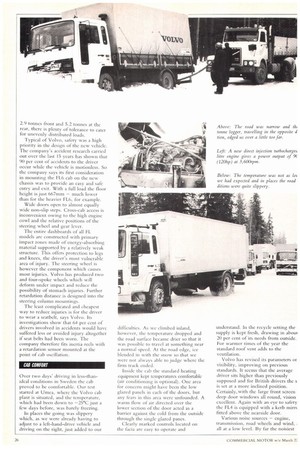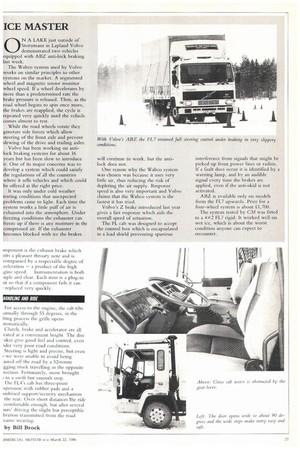JUNIOR IN THE BIG LEAGUE
Page 49

Page 50

Page 51

If you've noticed an error in this article please click here to report it so we can fix it.
Although it is plated at only 7.5 tonnes, Volvo's latest truck has all the refinements of its bigger brothers. CM has been testing a pre-production model in Sweden
F[IL F1.4, the latest addition to Volvo's new range of trucks, will bring the Swedish manufacturer's wer weight limit in the UK down to 5 tonnes — but not until later next !ar. Production of Continental models hich replace the F4, is due to start this pril, however. CM has already been to veden and carried out a limited test of pre-production vehicle.
PERFORMANCE
tiny (3. fl-litre) new direct-injection id turbocharged diesel engine powers e EL4. It is designated the TD41c; and developed from the 11)40 indirect lit which has been in production over e past nine years. The unit gives a iiwer output of 90kW(120hp) at a latively high engine speed of 3,600rpm id a high torque of 280Nm(207 lbft) so at a relatively (list 2.400 rpm. in common with the rest of the FL nge the FL4 has a rev counter with a
green sector indicating the most economic band within which to contain the engine speed. Fiore it extends from 2,100 to 3,0011rpm. With the 4.56 to 1 drive axle ratio, 1,5484rpin in fifth gear approximates to 50kmlh, or 2,000rpm in fourth gear.
After what at first seems like hard revving to 3,410(4rpin without changing up, it is possible to keep the needle within the green sector of the rev counter after each successive change.
With maximum torque occurring in the middle of the green band, the engine continues to pull well on level ground to below 1,500rpm.
We were unable to measure fuel consumption, but a constant-speed figure of 10 ht/100kin (28inpg) at 70kin/h(43mpli) is claimed. In adverse weather conditions over an urban route, consumption has been quoted as high as 201it/100km (14mpg). although a realistic figure is likely to be about 16ht/100km (17.5mpg).
BODYWORK The cab is the roomy FLO unit — a positive decision by Volvo to give the new truck large-vehicle comfort, even though this incurs a weight penalty. Savings have been achieved in other areas, though, to give a competitive 2.8 to 3.1-tonne unladen chassis cab weight, depending on the wheelbase.
The chassis frame is high-tensile steel which, although very strong, is also light.
Taper-leai springs with rubber spacers are to be offered Is an alternative to conventional multi-leaf spring packs.
Although disc brakes are not offered on the FL6 range for the UK market they will be standard fitment on all wheels of the FL4 which are not only lighter but also quicker and easier to service.
The range of wheelbase options is 2.8m to 4.6m and, with axles plated at 2.9 tonnes front and 5.2 tonnes at the rear, there is plenty of tolerance to cater for unevenly distributed loads.
Typical of Volvo, safety was a high priority in the design of the new vehicle. The company's accident research carried out over the last 15 years has shown that 90 per cent of accidents to the driver occur while the vehicle is motionless. So the company says its first consideration in mounting the FL6 cab on the new chassis was to provide an easy and safe entry and exit. With a full load the floor height is just 667mm — much lower than for the heavier FL6, for example.
Wide doors open to almost equally wide non-slip steps. Cross-cab access is inconvenient Owing to the high engine cowl and the relative positions of the steering wheel and gear lever.
The entire dashboards of all FL models are constructed with primary impact zones made of energy-absorbing material supported by a relatively weak structure. This offers protection to legs and knees, the driver's most vulnerable area of injury. The steering wheel is however the component which causes most injuries. Volvo has produced two and four-spoke wheels which will deform under impact and reduce the possibility of stomach injuries. Further retardation distance is designed into the steering column mountings.
The least complicated and cheapest way to reduce injuries is for the driver to wear a seatbelt, says Volvo. Its investigations show that 64 per cent of drivers involved in accidents would have suffered less or avoided injury altogether if seat belts had been worn. The company therefore fits inertia reels with a retardation sensor mounted at the point of cab oscillation.
CAB COMFORT Over two days driving in less-thanideal conditions in Sweden the cab proved to be comfortable. Our test started at Umca, where the Volvo cab plant is situated, and the temperature, which had been down to —25°C just a few days before, was barely freezing.
In places the going was slippery which, as we were already having to adjust to a left-hand-drive vehicle and driving on the right, just added to our difficulties. As we climbed inland, however, the temperature dropped and the road surface became drier so that it was possible to travel at something near a normal speed. At the road edge, ice blended in with the snow so that we were not always able to judge where the firm track ended.
Inside the cab the standard heating equipment kept temperatures comfortable (air conditioning is optional). One area for concern might have been the low glazed panels in each of the doors, but any fears in this area were unfounded. A warm flow of air directed over the lower section of the door acted as a barrier against the cold from the outside through the single glazed panes.
Clearly marked controls located on the facia are easy to operate and understand. In the recycle setting the supply is kept fresh, drawing in aboui 20 per cent of its needs from outside. For warmer times of the year the standard roof vent adds to the ventilation.
Volvo has revised its parameters or visibility, improving on previous standards. It seems that the average driver sits higher than previously supposed and for British drivers the s is set at a more inclined position. Certainly, with the large front screen deep door windows all round, vision excellent. Again with an eye to safety the FL4 is equipped with a kerb mim fitted above the nearside door.
Various noise sources — engine, transmission, road wheels and wind, ; all at a low level. By far the noisiest mponent is the exhaust brake which nits a pleasant throaty note and is companied by a respectable degree of .celeration — a product of the high ;gine speed. Instrumentation is both inple and clear. Each item is a plug-in iit so that if a component fails it can replaced very quickly.
HANDLING AND RIDE For access to the engine, the cab tilts lanually through 55 degrees, in the lting process the grille opens itomatically.
Clutch, brake and accelerator are all .cared at a convenient height. The disc 7akes give good feel and control, even ader very poor road conditions. Steering is light and precise, but even we were unable to avoid being asted off the road by a 52-tonne .gging truck travelling in the opposite rection. Fortunately, snow brought ; to a swift but smooth stop.
The FL4's cab has three-point ;spension with rubber pads and a imbined support/security mechanism the rear. Over short distances the ride comfortable enough, but after several iurs' driving the slight but perceptible bration transmitted from the road ;came wearing.
by Bill Brock






















































































